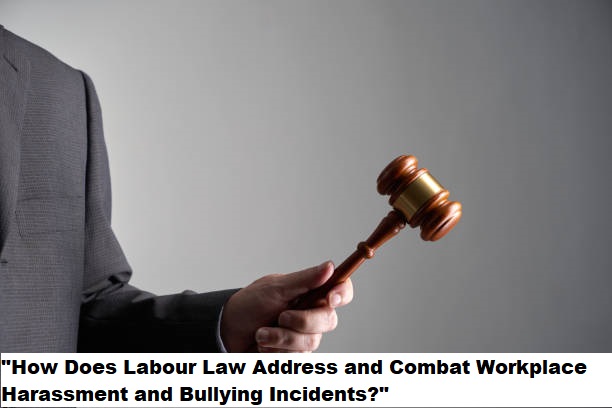introduction:
In this article, we will delve into the critical role of labor law in addressing and combating workplace harassment and bullying incidents. The workplace should be a space free from hostility, where employees feel respected and protected. Labor laws play a pivotal role in establishing guidelines and mechanisms to tackle instances of harassment and bullying, ensuring a safe and inclusive work environment. Let's explore six key outlines that shed light on how labor law addresses and combats such incidents.
- 1. **Legal Definitions: Clearly define and recognize harassment and bullying legally.
- 2. **Policy Development: Establish comprehensive anti-harassment and anti-bullying workplace policies.
- 3. **Reporting Procedures: Implement effective and confidential reporting mechanisms for incidents.
- 4. **Investigation Protocols: Develop thorough and fair protocols for investigating complaints.
- 5. **Preventive Measures: Proactively integrate training and awareness programs to prevent incidents.
- 6. **Legal Remedies: Outline legal remedies and consequences for perpetrators of harassment.
1. Legal Definitions: Clearly define and recognize harassment and bullying legally.
Labor laws establish precise definitions for workplace harassment and bullying, legally recognizing these harmful behaviors. By providing explicit definitions, labor laws ensure a common understanding, making it easier for employers and employees to identify and address such incidents. This clarity aids in the development and implementation of effective policies and procedures to combat harassment and bullying.
2. Policy Development: Establish comprehensive anti-harassment and anti-bullying workplace policies.
Labor laws guide the creation of robust workplace policies that address harassment and bullying. These policies outline unacceptable behaviors, clearly communicate the consequences for violations, and establish a framework for reporting and addressing incidents. Comprehensive policies, informed by labor law requirements, create a culture that prioritizes a safe and respectful workplace for all employees.
3. Reporting Procedures: Implement effective and confidential reporting mechanisms for incidents.
Labor laws emphasize the importance of implementing reporting procedures that are both effective and confidential. Employees need assurance that they can report harassment or bullying without fear of retaliation. These mechanisms often include multiple channels for reporting, ensuring accessibility for all employees. Confidentiality is crucial to protect the privacy of those involved and encourage open reporting, facilitating a swift response to incidents.
4. Investigation Protocols: Develop thorough and fair protocols for investigating complaints.
Labor laws guide the development of investigation protocols to ensure thorough and fair examinations of reported incidents. These protocols outline the steps to be taken, the parties involved, and the timeline for resolution. Fair investigations uphold the principles of natural justice, treating all parties involved with respect and providing an unbiased examination of the facts. The goal is to establish a transparent and accountable process that promotes confidence in the resolution of complaints.
5. Preventive Measures: Proactively integrate training and awareness programs to prevent incidents.
Labor laws underscore the importance of proactive measures to prevent workplace harassment and bullying. This includes the integration of training and awareness programs aimed at educating employees and employers about acceptable behavior, the impact of harassment, and the organization's commitment to a harassment-free workplace. Training fosters a culture of respect and understanding, reducing the likelihood of incidents and creating an environment where employees feel valued and protected.
6. Legal Remedies: Outline legal remedies and consequences for perpetrators of harassment.
Labor laws provide a framework for legal remedies and consequences for perpetrators of harassment and bullying. This may include disciplinary actions, termination, or legal consequences depending on the severity of the behavior. Establishing legal remedies sends a clear message that harassment and bullying are not tolerated, and the legal system is available to address such violations. These consequences serve as deterrents and reinforce the commitment to maintaining a safe and inclusive work environment.
Topic: "How Does Labour Law Address and Combat Workplace Harassment and Bullying Incidents?"
Addressing and combating workplace harassment and bullying incidents is a paramount concern, and labor laws play a central role in providing guidance and frameworks for effective prevention and resolution. The outlined measures, derived from labor law principles, form a comprehensive approach to create a workplace free from harassment and bullying.
Legal definitions within labor laws offer clarity, recognizing and defining harassment and bullying to facilitate understanding and identification. This foundation informs the development of comprehensive workplace policies, aligning with legal requirements and fostering a culture that prioritizes a safe and respectful environment.
Reporting procedures, guided by labor laws, emphasize the need for effective and confidential mechanisms, encouraging employees to come forward without fear of reprisal. Investigation protocols ensure a fair and thorough examination of complaints, upholding principles of transparency and accountability.
Proactive measures, such as training and awareness programs, are integral to preventing incidents. These programs, informed by labor laws, contribute to a workplace culture that values respect and understanding, reducing the likelihood of harassment and bullying.
Legal remedies and consequences, outlined by labor laws, establish a framework for addressing perpetrators of harassment. This not only serves as a deterrent but reinforces the commitment to a workplace where harassment and bullying are not tolerated.
Conclusion:
In conclusion, labor laws provide a robust framework for addressing and combating workplace harassment and bullying incidents. The legal definitions, policies, reporting procedures, investigation protocols, preventive measures, and legal remedies collectively contribute to fostering a workplace culture that prioritizes respect, inclusivity, and accountability. I hope organizations recognize the importance of aligning their practices with labor law principles to create environments where employees can thrive without fear of harassment or bullying. By adhering to these measures, employers can not only comply with legal standards but also contribute to a positive and safe workplace for all.







0 Comments